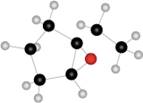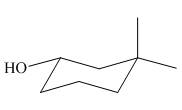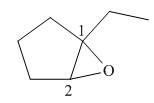
Name each compound depicted in the ball-and-stick models.
a.  b.
b.  c.
c. 
(a)
Interpretation: The name of given compound depicted in the ball-and-stick model is to be stated.
Concept introduction: One should follow the given steps to give the IUPAC name of cyclic alcohol. The first step is naming of ring that contains the carbon bonded to the hydroxyl group. While naming, the -e ending of parent cycloalkane must changed to the suffix -ol. The second step is numbering of carbon chain by providing lowest number to the
Answer to Problem 36P
The name of the given compound depicted in the ball-and-stick model is
Explanation of Solution
The given structure of alcohol is in the form of ball-and-stick model. It is converted into skeletal structure by replacing black ball with

Figure 1
One should follow the given steps to give the IUPAC name of cyclic alcohol. The first step is naming of ring that contains the carbon bonded to the hydroxyl group. While naming, the -e ending of parent cycloalkane must changed to the suffix -ol. The second step is numbering of carbon chain by providing lowest number to the
The above structure of cyclic alcohol shows that it consists of
Thus, the name of the given compound depicted in the ball-and-stick model is
The name of the given compound depicted in the ball-and-stick model is
(b)
Interpretation: The name of given compound depicted in the ball-and-stick model is to be stated.
Concept introduction: One should follow the given steps to give the IUPAC name of ether. The first step is naming of longest chain as an alkane and the shorter chain as an alkoxy group. The second step is applying the other nomenclature rules.
Answer to Problem 36P
The name of the given compound depicted in the ball-and-stick model is
Explanation of Solution
The given structure of ether is in the form of ball-and-stick model. It is converted into skeletal structure by replacing black ball with

Figure 2
One should follow the given steps to give the IUPAC name of ether. The first step is naming of longest chain as an alkane and the shorter chain as an alkoxy group. The second step is applying the other nomenclature rules.
The above structure of ether shows that it consists of
Thus, the name of the given compound depicted in the ball-and-stick model is
The name of the given compound depicted in the ball-and-stick model is
(c)
Interpretation: The name of given compound depicted in the ball-and-stick model is to be stated.
Concept introduction: One should follow the given steps to give the IUPAC name of an epoxyalkane. The first step is naming of alkane chain or ring to which oxygen atom is bonded, and using the epoxy (prefix) to name epoxide. The second step is designating the location of the atoms (using two numbers) to which the oxygen atom is bonded.
Answer to Problem 36P
The name of the given compound depicted in the ball-and-stick model is
Explanation of Solution
The given structure of epoxide is in the form of ball-and-stick model. It is converted into skeletal structure by replacing black ball with

Figure 3
One should follow the given steps to give the IUPAC name of an epoxyalkane. The first step is naming of alkane chain or ring to which oxygen atom is bonded, and using the epoxy (prefix) to name epoxide. The second step is designating the location of the atoms (using two numbers) to which the oxygen atom is bonded.
The above structure of epoxide shows that the cyclopentane ring is bonded to the epoxide ring on

Figure 4
Thus, the name of the given compound depicted in the ball-and-stick model is
The name of the given compound depicted in the ball-and-stick model is
Want to see more full solutions like this?
Chapter 9 Solutions
Organic Chemistry (6th Edition)
Additional Science Textbook Solutions
Microbiology: An Introduction
Physical Science
Biochemistry: Concepts and Connections (2nd Edition)
Human Biology: Concepts and Current Issues (8th Edition)
Fundamentals Of Thermodynamics
- curved arrows are used to illustrate the flow of electrons. using the provided starting and product structures, draw the cured electron-pushing arrows for thw following reaction or mechanistic steps. be sure to account for all bond-breaking and bond making stepsarrow_forwardUsing the graphs could you help me explain the answers. I assumed that both graphs are proportional to the inverse of time, I think. Could you please help me.arrow_forwardSynthesis of Dibenzalacetone [References] Draw structures for the carbonyl electrophile and enolate nucleophile that react to give the enone below. Question 1 1 pt Question 2 1 pt Question 3 1 pt H Question 4 1 pt Question 5 1 pt Question 6 1 pt Question 7 1pt Question 8 1 pt Progress: 7/8 items Que Feb 24 at You do not have to consider stereochemistry. . Draw the enolate ion in its carbanion form. • Draw one structure per sketcher. Add additional sketchers using the drop-down menu in the bottom right corner. ⚫ Separate multiple reactants using the + sign from the drop-down menu. ? 4arrow_forward
- Shown below is the mechanism presented for the formation of biasplatin in reference 1 from the Background and Experiment document. The amounts used of each reactant are shown. Either draw or describe a better alternative to this mechanism. (Note that the first step represents two steps combined and the proton loss is not even shown; fixing these is not the desired improvement.) (Hints: The first step is correct, the second step is not; and the amount of the anhydride is in large excess to serve a purpose.)arrow_forwardHi I need help on the question provided in the image.arrow_forwardDraw a reasonable mechanism for the following reaction:arrow_forward
- Draw the mechanism for the following reaction: CH3 CH3 Et-OH Et Edit the reaction by drawing all steps in the appropriate boxes and connecting them with reaction arrows. Add charges where needed. Electron-flow arrows should start on the electron(s) of an atom or a bond and should end on an atom, bond, or location where a new bond should be created. H± EXP. L CONT. י Α [1] осн CH3 а CH3 :Ö Et H 0 N о S 0 Br Et-ÖH | P LL Farrow_forward20.00 mL of 0.150 M NaOH is titrated with 37.75 mL of HCl. What is the molarity of the HCl?arrow_forward20.00 mL of 0.025 M HCl is titrated with 0.035 M KOH. What volume of KOH is needed?arrow_forward
- 20.00 mL of 0.150 M NaOH is titrated with 37.75 mL of HCl. What is the molarity of the HCl?arrow_forward20.00 mL of 0.025 M HCl is titrated with 0.035 M KOH. What volume of KOH is needed?arrow_forward20.00 mL of 0.150 M HCl is titrated with 37.75 mL of NaOH. What is the molarity of the NaOH?arrow_forward
 Chemistry for Today: General, Organic, and Bioche...ChemistryISBN:9781305960060Author:Spencer L. Seager, Michael R. Slabaugh, Maren S. HansenPublisher:Cengage Learning
Chemistry for Today: General, Organic, and Bioche...ChemistryISBN:9781305960060Author:Spencer L. Seager, Michael R. Slabaugh, Maren S. HansenPublisher:Cengage Learning Introductory Chemistry: An Active Learning Approa...ChemistryISBN:9781305079250Author:Mark S. Cracolice, Ed PetersPublisher:Cengage Learning
Introductory Chemistry: An Active Learning Approa...ChemistryISBN:9781305079250Author:Mark S. Cracolice, Ed PetersPublisher:Cengage Learning Chemistry: Principles and PracticeChemistryISBN:9780534420123Author:Daniel L. Reger, Scott R. Goode, David W. Ball, Edward MercerPublisher:Cengage Learning
Chemistry: Principles and PracticeChemistryISBN:9780534420123Author:Daniel L. Reger, Scott R. Goode, David W. Ball, Edward MercerPublisher:Cengage Learning Organic Chemistry: A Guided InquiryChemistryISBN:9780618974122Author:Andrei StraumanisPublisher:Cengage LearningChemistry: Matter and ChangeChemistryISBN:9780078746376Author:Dinah Zike, Laurel Dingrando, Nicholas Hainen, Cheryl WistromPublisher:Glencoe/McGraw-Hill School Pub Co
Organic Chemistry: A Guided InquiryChemistryISBN:9780618974122Author:Andrei StraumanisPublisher:Cengage LearningChemistry: Matter and ChangeChemistryISBN:9780078746376Author:Dinah Zike, Laurel Dingrando, Nicholas Hainen, Cheryl WistromPublisher:Glencoe/McGraw-Hill School Pub Co World of Chemistry, 3rd editionChemistryISBN:9781133109655Author:Steven S. Zumdahl, Susan L. Zumdahl, Donald J. DeCostePublisher:Brooks / Cole / Cengage Learning
World of Chemistry, 3rd editionChemistryISBN:9781133109655Author:Steven S. Zumdahl, Susan L. Zumdahl, Donald J. DeCostePublisher:Brooks / Cole / Cengage Learning





